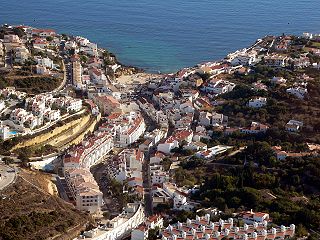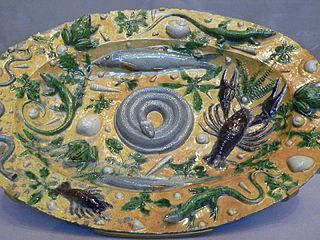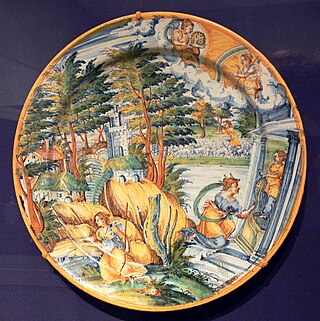
The Algarve is the southernmost NUTS II region of continental Portugal. It has an area of 4,997 km2 (1,929 sq mi) with 467,495 permanent inhabitants and incorporates 16 municipalities.

Faience or faïence is the general English language term for fine tin-glazed pottery. The invention of a white pottery glaze suitable for painted decoration, by the addition of an oxide of tin to the slip of a lead glaze, was a major advance in the history of pottery. The invention seems to have been made in Iran or the Middle East before the ninth century. A kiln capable of producing temperatures exceeding 1,000 °C (1,830 °F) was required to achieve this result, after millennia of refined pottery-making traditions. The term is now used for a wide variety of pottery from several parts of the world, including many types of European painted wares, often produced as cheaper versions of porcelain styles.

In different periods of time and in different countries, the term majolica has been used for two distinct types of pottery.

Carvoeiro is a town and a former civil parish in the municipality (concelho) of Lagoa, Algarve, Portugal. In 2013, the parish merged into the new parish Lagoa e Carvoeiro. The population in 2011 was 2,721, in an area of 11.66 km². It is located about 5 kilometres (3.1 mi) south of Lagoa.

Maiolica is tin-glazed pottery decorated in colours on a white background. The most renowned Italian maiolica is from the Renaissance period. These works were known as istoriato wares when depicting historical and mythical scenes. By the late 15th century, multiple locations, mainly in northern and central Italy, were producing sophisticated pieces for a luxury market in Italy and beyond. In France, maiolica developed as faience, in the Netherlands and England as delftware, and in Spain as talavera. In English, the spelling was anglicised to majolica.

Azulejo is a form of Portuguese and Spanish painted tin-glazed ceramic tilework. Azulejos are found on the interior and exterior of churches, palaces, ordinary houses, schools, and nowadays, restaurants, bars and even railways or subway stations. They are an ornamental art form, but also had a specific functional capacity, like temperature control in homes.
Portugal has a long music history, beginning around the year 600 C.E, which accompanied and strongly contributed to the development of the music history in Europe.

Lagoa is a city and municipality in the district of Faro, in the Portuguese region of Algarve. The population of the municipality in 2011 was 22,975, in an area of 88.25 km2. Its urban population, in the city of Lagoa proper, is 6,100 inhabitants. An important travel destination, its coast has won numerous accolades. Marinha Beach was considered by the Michelin Guide as one of the 10 most beautiful beaches in Europe and as one of the 100 most beautiful beaches in the world.

Mintons was a major company in Staffordshire pottery, "Europe's leading ceramic factory during the Victorian era", an independent business from 1793 to 1968. It was a leader in ceramic design, working in a number of different ceramic bodies, decorative techniques, and "a glorious pot-pourri of styles - Rococo shapes with Oriental motifs, Classical shapes with Medieval designs and Art Nouveau borders were among the many wonderful concoctions". As well as pottery vessels and sculptures, the firm was a leading manufacturer of tiles and other architectural ceramics, producing work for both the Houses of Parliament and United States Capitol.

Palissy ware is a 19th-century term for ceramics produced in the style of the famous French potter Bernard Palissy, who referred to his own work in the familiar manner as rustique. It is therefore also known as rusticware. Palissy's distinctive style of polychrome lead-glazed earthenware in a sombre earth-toned palette, using naturalistic scenes of plants and animals cast from life, was much imitated by other potters both in his own lifetime and especially in the 19th century. In this revival, pottery in Palissy's style was produced by Charles-Jean Avisseau of Tours, who rediscovered Palissy's techniques in 1843, his relatives the Landais family of Tours, Georges Pull of Paris, Maurice, and Barbizet.

Tin-glazed pottery is earthenware covered in lead glaze with added tin oxide which is white, shiny and opaque ; usually this provides a background for brightly painted decoration. It has been important in Islamic and European pottery, but very little used in East Asia. The pottery body is usually made of red or buff-colored earthenware and the white glaze imitated Chinese porcelain. The decoration on tin-glazed pottery is usually applied to the unfired glaze surface by brush with metallic oxides, commonly cobalt oxide, copper oxide, iron oxide, manganese dioxide and antimony oxide. The makers of Italian tin-glazed pottery from the late Renaissance blended oxides to produce detailed and realistic polychrome paintings.

Artisanal Talavera of Puebla and Tlaxcala is a Mexican pottery tradition with heritage from the Talavera de la Reina pottery of Spain. In 2019, both traditions were included in UNESCO's Representative List of the Intangible Cultural Heritage of Humanity.
The Convent of Saint Joseph is a former convent and current cultural centre of Lagoa, situated in the civil parish of Lagoa, urbanized part of the city of Lagoa, Portugal. Built on the north edge of the old quarter, with its belvedere tower straddling the main road north to Silves, it hosts exhibitions of painting, photography, sculpture and pottery, as well as various shows and discussions in its auditorium.

Porches is a civil parish/freguesia in the municipality of Lagoa in Portugal, about 10 km east of the city of Lagoa. The population in 2011 was 2,011, in an area of 15.64 km2. It was elevated to the status of a town on July 12, 2001.

The Church of Our Lady of the Incarnation is a church situated in the civil parish of Porches, in the municipality of Lagoa in the Portuguese region of Algarve.
Patrick Swift (1927–1983) was an Irish painter who worked in Dublin, London and the Algarve, Portugal.
Katherine Swift (1956–2004) was an Irish-born Portuguese painter, illustrator and ceramicist.
Estudio Destra is a Ceramics/Pottery Workshop based in Silves, Algarve, Portugal.

Ceramics in Mexico date back thousands of years before the Pre-Columbian period, when ceramic arts and pottery crafts developed with the first advanced civilizations and cultures of Mesoamerica. With one exception, pre-Hispanic wares were not glazed, but rather burnished and painted with colored fine clay slips. The potter's wheel was unknown as well; pieces were shaped by molding, coiling and other methods.

Lima de Freitas was a Portuguese painter, illustrator, ceramicist and writer. He studied at the Escola Superior de Belas Artes de Lisboa.














